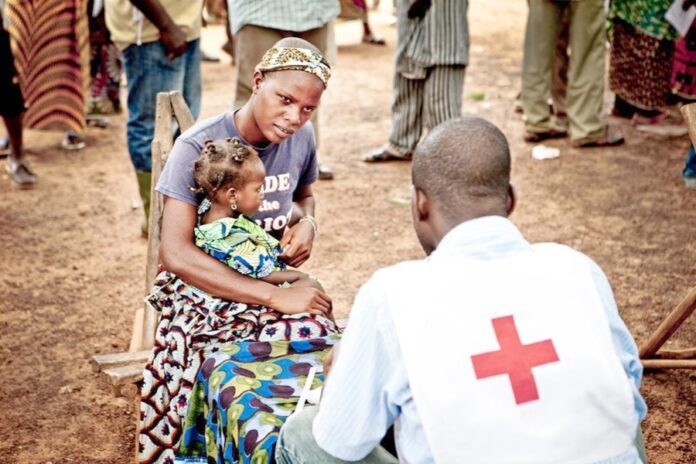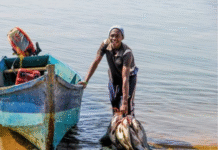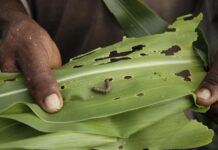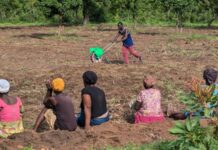Illustrative Image: Angola’s Fight Against Sleeping Sickness: Progress, Strategies, and Path to Eliminating Gambiense Human African Trypanosomiasis by 2030
Image Source & Credit: WHO
Ownership and Usage Policy
A recent study by Ouma et al. (2025) titled “Bold strides towards the elimination of gambiense human African trypanosomiasis (gHAT) as a public health problem—A case study of Angola” published in PLOS Neglected Tropical Diseases, reveals Angola drastically reduced gHAT cases, nearing WHO validation for elimination as a public health problem, targeting complete eradication by 2030.
“
Angola has dramatically reduced gHAT cases through integrated control strategies and is on track for WHO-validated elimination by 2030.
– Ouma et al. 2025
Gambiense human African trypanosomiasis (gHAT), commonly known as sleeping sickness, is a chronic parasitic disease caused by Trypanosoma brucei gambiense and transmitted by tsetse flies. Angola has historically been one of the most affected countries, with major epidemics recorded in the 1920s–1940s and again in the 1990s–2000s. Today, up to one-third of the country’s population remains at risk, particularly across seven endemic provinces. The disease was first reported in Angola in 1871, with organized control efforts beginning in 1901. Early colonial-era interventions included bush clearing, patient isolation, and mass drug administration. These measures were later reinforced by the introduction of mobile teams and large-scale chemotherapy programs in the mid-20th century, which brought significant reductions in case numbers. Following Angola’s civil war, the government revitalized its HAT control program in 2002 through the Instituto de Combate e Controlo das Tripanossomiases (ICCT).
Key strategies included active and passive screening with rapid diagnostic tests, intensified vector control using traps and insecticide spraying, and community awareness campaigns. Strong international partnerships with organizations such as Trypa-NO!, DNDi, and WHO further strengthened Angola’s response. As a result, annual cases fell dramatically—from an average of 3,496 between 1990 and 2006 to just 56 between 2016 and 2023. Surveillance and treatment coverage also expanded, with 157 health facilities now equipped to diagnose and manage gHAT. The introduction of fexinidazole, the first all-oral treatment for sleeping sickness, simplified patient care and improved accessibility. Despite these successes, challenges remain. Civil conflict, the COVID-19 pandemic, and continued population movement through tsetse-infested areas have disrupted progress. Animal reservoirs and surveillance gaps also pose risks, contributing to occasional fluctuations in case numbers. Looking ahead, Angola aims to eliminate gHAT as a public health problem by 2030. Planned strategies include intensifying vector control, strengthening surveillance, enhancing cross-border collaborations, and preparing a technical dossier for WHO validation. This case study highlights Angola’s remarkable progress and offers valuable lessons for other endemic countries committed to eliminating sleeping sickness.
How the Study was Conducted
The study employed a retrospective case analysis of Angola’s national efforts to eliminate gambiense human African trypanosomiasis (gHAT), covering the period 1901 to 2023. Using a descriptive approach, the researchers compiled historical and recent data on control activities, programmatic milestones, epidemiological trends, and strategic interventions. Data sources included national surveillance records from the Instituto de Combate e Controlo das Tripanossomiases (ICCT), reports from WHO, DNDi, and Trypa-NO!, as well as published literature and internal program documents. The analytical focus centered on case detection trends, screening coverage, treatment outcomes, the deployment and impact of vector control, the expansion of health infrastructure and diagnostic capacity, and the introduction of new treatments such as fexinidazole. Progress was assessed against WHO elimination targets, particularly reducing incidence to fewer than one case per 10,000 population in endemic areas, sustaining surveillance and response capacity, and preparing for the validation of elimination as a public health problem. This integrated approach allowed the study to document Angola’s achievements, highlight ongoing challenges, and outline priorities for the final steps toward the full elimination of gHAT.
What the Authors Found
The study found that Angola has achieved a dramatic reduction in gambiense human African trypanosomiasis (gHAT) cases and is now on the verge of eliminating the disease as a public health problem, positioning itself for WHO validation and aiming for full elimination by 2030.
Why is this important
Global and Scientific Significance
Angola’s near-elimination of gHAT demonstrates that neglected tropical diseases can be controlled in resource-limited settings, aligning with WHO’s 2030 roadmap. The study also documents proven strategies—such as mobile screening, oral treatments, and vector control—that can be replicated elsewhere.
National Public Health Triumph
Angola’s transition from epidemic outbreaks to near-elimination strengthens its health infrastructure, enhances resilience against future vector-borne diseases, and marks a major milestone in national health progress.
Broader Lessons for Disease Control
The integrated approaches—rapid diagnostics, community engagement, surveillance, and cross-border coordination—offer transferable lessons for tackling other neglected diseases like leishmaniasis and Chagas disease.
Policy and Investment Blueprint
By showcasing what works in real-world contexts, the study provides actionable guidance for policymakers, donors, and NGOs, reinforcing the case for sustained investment in elimination programs globally.
What the Authors Recommended
- The study emphasises expanding passive surveillance nationwide, maintains active screening in high-risk areas, and improves data systems for early detection and monitoring.
- The authors advocate scaling up tsetse fly control using traps and insecticide-treated targets while integrating efforts with community participation to ensure sustainability.
- Guarantee availability of RDTs and fexinidazole in all endemic zones, alongside training health workers in case management and differential diagnosis.
- Strengthen coordination with neighboring countries through shared surveillance data, harmonized control strategies, and measures to prevent reintroduction via migration.
- Develop and submit a technical dossier documenting progress, case data, and surveillance capacity to support validation of elimination as a public health problem.
- In addition, secure ongoing government backing and international funding, embedding gHAT elimination within broader health system strengthening and NTD programs.
Angola’s remarkable progress in reducing gHAT cases demonstrates that sustained surveillance, effective treatment, community engagement, and strategic vector control can bring neglected tropical diseases to the brink of elimination, offering a model for other endemic countries and reinforcing global health efforts toward the 2030 targets.
















 The African Research (AR) Index is a comprehensive scholarly directory and database focused explicitly on journal publishers that publish and disseminate African research.
The African Research (AR) Index is a comprehensive scholarly directory and database focused explicitly on journal publishers that publish and disseminate African research.

